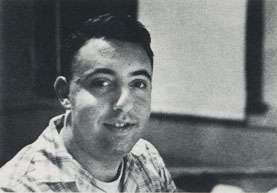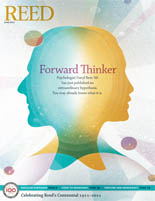
IRIS login | Reed College home Volume 90, No. 2: June 2011
Forward Thinker (continued)
![]()
“Pick a card,” Bem said. “Any card.”
We were sitting in his living room, and he was shuffling the deck. I chose the two of hearts. Bem shuffled again, with panache, and then beseeched me to draw from the deck. Naturally, I drew the two of hearts again.

Physics major Daryl Bem poses for the 1960 Griffin.
“How did that work?” I asked, befuddled.
“Very well,” Bem said, “and if I told you, I’d have to kill you.” Soon he relented, though, and divulged the quotidian mechanics behind his trick.
“Giving the secrets away makes me very unpopular among magicians,” he said, “but I’m an educator as well as a magician.”
It was his interest in magic, in fact, that first led him to study ESP. In 1985, the Parapsychological Association, an international group comprising some 300 psi researchers, invited Bem to their annual convention in Boston, so he could show them how to avoid being duped by mentalists faking ESP.
Bem brought a certain skepticism to the meeting. He’s never had a single profound ESP experience. He’s never, say, conjured up a certain six-digit number and rushed to the convenience store, absolutely certain that he knows which lottery ticket to buy, and he’s dubious of the statistical sloppiness with which most people regard alleged miracles of premonition. “People read about them in the paper and they say, ‘That’s amazing! What are the odds of that happening?’ The real question we should ask is, ‘How many other people had premonitions that day and bought losing lottery tickets?’”
Bem is equally leery of zealous skeptics who ask him questions like, “If ESP truly existed, why aren’t there people out there making a living predicting the future?” To this query, he responds, “How do you know there aren’t?”
What struck Bem when he got to Boston was the “robustness” of the reports on ESP that he read, particularly the ’70s-era “ganzfeld” experiments in which researcher Chuck Honorton subjected subjects to sensory deprivation to test for telepathy. Honorton placed “receivers” in a comfortable chair, strapped halved ping pong balls over their eyes, and played white noise into their headphones. He found that they could identify target objects that “senders” had been thinking about significantly more often than chance would predict.
The evidence from the ganzfeld experiments was so impressive, Bem says, that he offered to help Honorton get his laboratory findings into an academic journal, eventually coauthoring a paper with him in the Psychological Bulletin.
As astonishing as these results were, Bem says, scientists at least have a conceptual framework for telepathy. “There are plenty of ways that communication happens invisibly,” he explains. “There are cell phones and radio. People have a mental image as to how telepathy might work.” Precognition is different, though. “We can’t imagine that causation can go backwards in time,” he says. “But does time really only flow forward? Now, that’s a puzzle.”
And not just a problem for psychology. In retirement, Bem is returning to his first intellectual love, physics, and finding in the discipline an explanation for precognition. As he notes in “Feeling the Future,” the field of quantum mechanics, like psi research, is premised on a model of reality that is “nonlocal: It must allow for the possibility that particles that have once interacted can become entangled”—that is, entwined, so that, even if they are spatially separate, they spin in relation to one another.
Entanglement is an accepted concept in physics; it was first described by Albert Einstein in 1935. Now Bem is suggesting that entanglement may manifest psychologically, too—that a person’s mind may be able to be . . . essentially elsewhere, interacting with stimuli that transcend the person’s immediate reality—even with stimuli that do not yet exist. Bem concedes that there is no laboratory proof for such entanglement, but he enthusiastically quotes from the 2006 book, Entangled Minds, by psi researcher Dean Radin: “The ontological parallels implied by entanglement and psi are so compelling that I believe they’d be foolish to ignore.”
Many of Bem’s colleagues are, naturally, rolling their eyes. When I met with the chair of Cornell’s psychology department, Tom Gilovich, he quoted the British novelist Ian McEwan, who lashes out at quantum mechanics in his latest book, calling it “a repository, a dump, of human aspiration.” The field, McEwan insists, is “the borderland where mathematical rigor defeated common sense, and reason and fantasy irrationally merged. Here the mystically inclined could find whatever they required and claim science as their proof.”
Gilovich brims with respect for Bem’s “terrific experiment. It’s well-crafted and it’s inventive, and it presents intriguing evidence.” Still, he says, “I think there’s some bug in the program, some tiny mistake that we’ve yet to figure out.”
Schooler, the psychologist at the University of California at Santa Barbara, also harbors some skepticism. As chronicled in a recent New Yorker story, Schooler studies “the decline effect,” which describes a pattern that he says is common to myriad forms of statistical research: initial studies clearly confirm a dazzling result and then subsequent studies prove less convincing. The statistics sag. The truth somehow wears out and, Schooler asserts, the erosion rate is particularly bad when it comes to parapsychological experiments. “Whenever we’ve done experiments in the paradigm Bem describes,” he says, “we got effects the first time, and then we saw decline.”
Recently, two professors—Jeff Galak of Carnegie Mellon and Leif Nelson of the University of California at Berkeley—repeated Bem’s “retroactive recall” vocabulary tests. They failed to replicate Bem’s confirmation of ESP.
When I dropped by his condo one last time before leaving Ithaca, Bem told me, “I worry about the decline effect. I worry about it a lot.” He was still wearing the same rumpled plaid shirt and the same blue pants he wore on the previous day. “I think that the decline effect has something to do with the enthusiasm of the experimenter decreasing.” He added that there’s another impediment to psi research: “ESP is regarded as superstitious nonsense. And so people learn to suppress it. You don’t practice precognition. You don’t take confidence in your skills and when you’re asked to, say, pick between two pictures.”
Still, Bem is undeterred. This spring at Cornell, he plans to take his “retroactive recall” study out of the lab and ask students in one Cornell psych class to study for a multiple choice test after turning in their exam books. “I just think it’d be neat to see what happens,” he told me. “I like solving puzzles.”
Bem didn’t elaborate, for now he was heading out. He had a meeting planned with his personal trainer, and he was attending reluctantly, playing the wise guy psychologist all the way.
As we stood out in the cold by his garage, he told me one more story. “The last time I went to the gym,” he said, “we lifted some weights and then the trainer asked me, ‘Do you want me to go upstairs to watch you do cardio?’ I told her, ‘No, the mere threat that you might come up is enough.’”
FURTHER READING
Daryl J. Bem, “Feeling the Future: Experimental Evidence for Anomalous Retroactive Influences on Cognition and Affect,” Journal of Personality and Social Psychology, 100, 407-425. http://dbem.ws/FeelingFuture.pdf
Eric-Jan Wagenmakers et al., Yes, Psychologists Must Change the Way They Analyze Their Data: Clarifcations for Bem, Utts, and Johnson (2011), http://dl.dropbox.com/u/1018886/ClarificationsForBemUttsJohnson.pdf
Daryl J. Bem, Must Psychologists Change the Way They Analyze Their Data? A Response to Wagenmakers et al., http://dl.dropbox.com/u/8290411/ResponsetoWagenmakers.pdf
The Structure of Scientific Revolutions, by Thomas Kuhn.
- Previous Page
- 1
- 2
- 3
- Next Page


LATEST COMMENTS
steve-jobs-1976 I knew Steve Jobs when he was on the second floor of Quincy. (Fall...
Utnapishtim - 2 weeks ago
Prof. Mason Drukman [political science 1964–70] This is gold, pure gold. God bless, Prof. Drukman.
puredog - 1 month ago
virginia-davis-1965 Such a good friend & compatriot in the day of Satyricon...
czarchasm - 4 months ago
John Peara Baba 1990 John died of a broken heart from losing his mom and then his...
kodachrome - 7 months ago
Carol Sawyer 1962 Who wrote this obit? I'm writing something about Carol Sawyer...
MsLaurie Pepper - 8 months ago
William W. Wissman MAT 1969 ...and THREE sisters. Sabra, the oldest, Mary, the middle, and...
riclf - 10 months ago